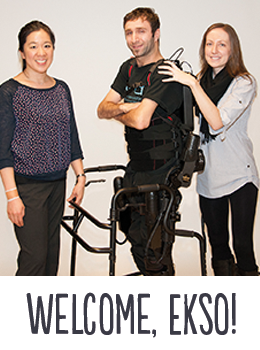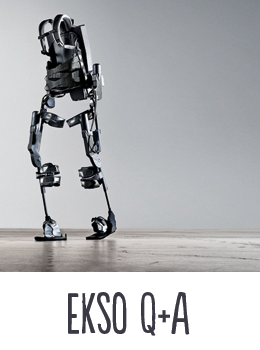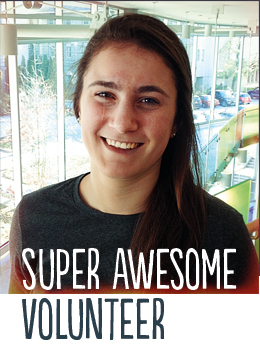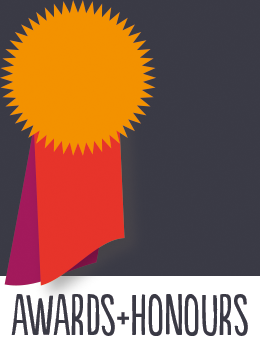Welcome to the second issue of the ICORDian community newsletter. In this issue, we introduce you to the newest addition to ICORD’s Rehab Research lab, give you an update on last November’s Spinal Chord gala, and profile one of our amazing and dedicated volunteers. Our Research in Focus column looks at the relationship between damage to the bones of the neck and damage to the spinal cord. We also highlight some research projects that you might find interesting, and some new publications by ICORD researchers.
Contents
- ICORD gets a new tool for rehab research
- Ekso Q+A
- Spinal Chord Gala review
- Community research meeting
- Take part in a research study
- Research in focus: relationship between neck injury and damage to the spinal cord
- Amanda Giacomazza: super awesome volunteer!
- Recent publications by ICORD researchers
- ICORD award winners
 ICORD gets a new tool for rehab research
ICORD gets a new tool for rehab research
Mustafa Hasan says it was like his “dream coming true” when he put on ICORD’s new EksoTM Suit in early January and walked. The Ekso is a wearable bionic suit that enables people with limited strength in their legs to stand and walk with a natural gait.
Mustafa suffered a spinal cord injury in 2003 when a bomb exploded near his home in Baghdad. When he moved to Canada, he started rehab at GF Strong Rehabilitation Centre, and learned about the research going on at ICORD from one of his therapists. Since then, he has participated in many research studies. “Each study gives me more knowledge about my body and how to be more fit living with my disability,” he said.
A few years ago, Mustafa was flipping through a magazine and saw some photos of futuristic Japanese bionic suits. “This is when my dream started,” he said. Unfortunately, the suits were prohibitively expensive. Then, in the fall of 2012, he went to a demonstration of an Ekso suit at ICORD, and was excited at the possibility that this new technology might one day be accessible to him. “Even during the demonstration, I was imagining myself already using that suit.”
Fast forward to January of 2014: a brand new Variable Assist Ekso Suit has arrived at ICORD, and Mustafa is asked by ICORD PI Dr. Tania Lam and postdoctoral research fellow Dr. Amanda Chisholm if he would be willing to help them learn to use it.
“I was a bit nervous, but so happy when I first tried the suit,” said Mustafa. Initially he found it hard to balance. “I had to stand the way Ekso wanted me to,” he explained. “It was hard at first, but then I started to understand what I could do with it. My dream is to one day use the Ekso in my daily living, until there is a cure for paralysis.”
Dr. Lam and her research team will be conducting research with the Ekso suit in both variable-assist mode (where the suit helps you walk if you can walk a bit) and full-assist mode (where the suit makes the steps for you), to investigate functions like gait and postural control and other indicators of health outcomes, as well as whether using the suit can affect the quality of someone’s gait pattern, and whether the benefits of using of the suit can translate into other activities of daily living. She expects to start recruiting study participants within the next year.
ICORD is grateful for the support of the Canada Foundation for Innovation, BC Knowledge Development Fund and Rick Hansen Foundation, which enabled the purchase of the Ekso suit.
 Questions and Answers about the Ekso
Questions and Answers about the Ekso
Q: Who can use the Ekso suit?
A: Generally, you can use the Ekso if you are up to 183cm (6 feet) tall and 100kg (220 lbs). People with SCI need to be paraplegic (with hand/arm function or motor incomplete, and enough strength in their arms to use a gait aid like a walker or crutches). Spasticity and tone are other considerations (the joints in your legs and ankles need to be able to be passively moved into a neutral position). You need to have a physiotherapist with you when you are using the Ekso suit.
Q: What can the Ekso do?
A: The Ekso can move you from a sitting position to a standing position, move your legs (or help you move your legs) so you can walk in a straight line over even ground, and move you from standing to sitting.
Q: What can’t it do?
A: It can’t help you shift your weight, or keep you from falling. And even though it looks like it should be able to moonwalk like a pro, it can’t help you dance (yet).
Q: Is it hard to use?
A: Well . . . it does require quite a lot of training. First, the therapists (who are required to have a clinical background in physiotherapy) need to learn:
- how to properly fit the suit to a user and line up the user’s body with the Ekso frame,
- what all the buttons do,
- how to properly instruct the user,
- how to use the suit safely.
Then, with the help of the physiotherapist, the users need to:
- focus on shifting their weight from side to side
- work on properly controlling the position of their centre of mass while walking
- retrain their bodies to move in a different way (if they already use gait aids)
Q: How much did the Ekso suit cost?
A: The Ekso cost around $100,000 (US). ICORD was able to purchase it thanks to an infrastructure grant from the federal government.
Q: When can I get into the Ekso?
A: Dr. Lam and her team are still learning how to use the suit and train users. They are planning some research studies and expect to start recruiting within the next year. If you meet the general requirements for use, you could be able to participate in a study. We’ll be posting recruitment notices on Facebook, and the Research Studies Page on the ICORD website.
 Spinal Chord 2013 review
Spinal Chord 2013 review
The 2013 Spinal Chord gala last November was great fun, with about 240 sparkling guests enjoying wonderful music from the Vancouver Cantata Singers and the Capilano College Jazz Quartet in the spectacular and beautifully-decorated atrium of the Blusson Spinal Cord Centre. The event raised almost $40,000 in support of ICORD and the Vancouver Cantata Singers. Presented by Medtronic and supported by a long list of very generous sponsors, this annual interdisciplinary event celebrates the achievements and objectives of our two internationally recognized organizations, and gives us the opportunity to come together and identify common ground and shared perspectives in our varied pursuits. As far as we know, no other partnerships between arts and research organizations like this exist in the province. With the exception of specific cash donations, all funds generated by this event are split equally between both organizations.
Community research meeting 
We are pleased to announce that the first ever community research meeting will take place on March 3rd in the atrium of the Blusson Spinal Cord Centre. This is part of the Rick Hansen Institute’s Consumer Engagement Program, in partnership with ICORD and SCI-BC.
Everyone is welcome to participate in this free public event to discuss the innovative work happening in SCI research and how it will impact people with SCI. The featured speaker is Dr. Jerry Silver, Professor of Neuroscience at Case Western Reserve University in Cleveland, OH. Dr. Silver’s talk will focus on what’s on the horizon for SCI regeneration research.
5:30pm – Snacks, mingling | 6:00 – Talk by Dr. Silver | 6:30 – Talk by Dr. Brian Kwon | 7:00 – Q+A and discussion
Space is limited. This event is free, but registration is required. Click here to register.
 Take part in a research study!
Take part in a research study!
We have lots of interesting studies going on at ICORD. Some of them take just a few minutes of your time, others require one or more visits to ICORD. By participating in a study, you are helping researchers learn about potential new treatments or rehabilitation strategies for SCI, and you might learn something interesting while you’re at it. You get free parking at the BSCC, your other expenses are generally covered, and sometimes there are other perks. These are just a few of the studies recruiting right now (click on the links for complete details including requirements for participation):
- Eye movements in wheelchair users (have your eye movements tracked using a video camera)
- Interviews about stem cell tourism (complete a survey)
- Botox for overactive bladder and prevention of autonomic dysreflexia following SCI (receive an in-depth cardiovascular and bladder health assessment: complete some questionnaires, have your blood pressure monitored, have urodynamic testing, and possibly receive Botox treatments)
- Physical Activity Research Centre (complete a PARmed-X and some assessments, then have the opportunity to work out in a fully-accessible gym)
- EPICWheels: a feasibility study (take a 1-month customized home training program for your power wheelchair)
- Bowel care and cardiovascular function after SCI (complete a survey, meet a Nurse continence advisor if you like).
 Research in Focus
Research in Focus
Find out what’s going on in SCI research in this regular column on the SCRIBE Blog. Our blog presents easy-to-understand summaries of published SCI research happening at ICORD and around the world. We are aiming to capture main ideas and points of interest from the research articles, but for all the details, you can read the full papers. In this issue, we present a summary by PhD student Stephen Mattucci of a paper by Shannon G. Kroeker and Randal P. Ching entitled Coupling between the spinal cord and cervical vertebral column under tensile loading, which was published in the Journal of Biomechanics 46 (2013) 773-779.
Relationship between neck injury and damage to the spinal cord
Many safety measures, such as car safety ratings, are determined using a ‘neck injury criteria’ which is based on forces experienced by the neck and spine, and does not include what happens to the spinal cord if the spine and neck are damaged. The spinal cord is a long bundle of nerves connecting the brain stem to the nerves of the body, and floats in fluid protected by the bones of the neck and spine. When the spine is damaged, the spinal cord can often be damaged too, but may not be damaged to the same degree as the bones of the spine. This study looked to develop a relationship between strain of the neck vertebrae (bones) and strain of the spinal cord, or comparing one type of strain relative to another. That way, if someone runs a test where they can measure what happens to the bones of the neck or spine, they can have an idea of how serious the strain is on the spinal cord. In this study, researchers used an animal model of SCI to apply strain on neighbouring sections of the spine and neck. They measured the strain that resulted on the spinal cord and spine and neck bones (vertebrae) by x-ray and calculated a ratio of head-to-neck strain. This ratio offers a way to calculate how much the spinal cord deforms when the spine and neck bones are under a given amount of strain. So when creating guidelines, this could be used to help establish allowable limits of strain to the neck and spine in real-life situations (like roll-over car accidents) that would still protect the spinal cord. Interestingly, researchers found in this experiment that the largest strain before bones break within the spine and neck did not always match with the location of the largest strain on the spinal cord. Work like this is useful in helping us to understand how the spinal cord is actually becoming injured, and what injuries to the spine and neck can cause this. It can help to develop better safety standards for applications where neck injuries are most common.
 Meet an ICORD volunteer
Meet an ICORD volunteer
Amanda Giacomazza is a second year UBC Kinesiology student and a PARC volunteer since the facility opened in April of last year. After her undergrad, she hopes to study medicine. She’s a soccer-playing lifeguard, and in a couple of months she’ll be heading to McMaster University with 24 of her Kin classmates to take part in the Kin Games where they’ll compete against students from across the country in academics, sports and dance. Amanda loves talking with all the different PARC participants and hearing their interesting stories. PARC supervisor Megan Brousseau thinks Amanda is awesome because takes the initiative to meet everyone that comes to the PARC and to remember them and the things going on in their lives. “She is constantly interacting with people and encouraging them to reach their potential or just chat if they’re not having a good day. She is always smiling, positive, approachable and eager to help. As a volunteer, she is proactive and will find the answer if she doesn’t already know it. She is reliable and responsible and has made a real impact on the individuals that come in on her shifts,” said Megan. “We are lucky to have her.” Thanks, Amanda!
Recent ICORD publications
Are you interested to know about what’s going on in ICORD labs? These are just a few recent publications by ICORD researchers.
A high fat, low carb diet can improve functional recovery after SCI. Drs. Femke Streijger and Wolfram Tetzlaff and their colleagues showed in rodent models that starting a ketogenic (high fat, low carb) diet after acute incomplete cervical SCI results in better forelimb function following injury. The paper suggests that current nutritional guidelines for people with acute SCI, which include lots of carbohydrates, should be reviewed. The ketogenic diet is now being studied in humans, with a joint pilot clinical trial by Dr. Tetzlaff and researchers in China. See more.
A new type of material for tissue engineering. Dr. Stephanie Willerth and her colleagues investigated different parameters that affect the manufacture of microfiber scaffolds. These scaffolds are used in neural tissue engineering to help increase the survival of transplanted cells. See more.
Using waist circumference to identify risk of cardiovascular disease in people with SCI. People who are obese have a high risk of cardiovascular disease, but accurately determining obesity in people with SCI can be challenging. Dr. Victoria Claydon and her team correlated a number of standard body-related measures of obesity with metabolic risk factors for cardiovascular disease. They found that waist circumference is the best measure to determine obesity and predict cardiovascular disease risk in people with SCI. See more.
 ICORD Award Winners
ICORD Award Winners
Congratulations to ICORD trainees Jacqueline Cragg and Dr. Chris West, who’ve both received prestigious awards recently. Jacqueline, who is a PhD student working with Dr. Jaimie Borisoff and Dr. Andrei Krassioukov, won the Minerva Foundation’s Emerging Leader in Science award in November, as well as the 2013 Harry and Florence Dennison Fellowship in Medical Research from the UBC Faculty of Medicine in January.
Chris, who is a postdoctoral research fellow in Dr. Andrei Krassioukov’s lab, won the 2013 Sam Schmidt Paralysis Foundation/Sell Fund Research Award from the American Spinal Injury Association, which augments his fellowships from the Craig Neilsen Foundation and Michael Smith Foundation for Health Research.
It’s not just our trainees who are recent award-winners. In November, ICORD Principal Investigator Dr. Stephanie Willerth was awarded a Tier 2 Canada Research Chair in Biomedical Engineering. Funded by the federal government, Tier 2 Chairs provide support for five years and are renewable once. They are awarded to exceptional emerging researchers, acknowledged by their peers as having the potential to lead in their field.
Dr. Miriam Spering and Dr. Ipek Oruc were among eighteen UBC researchers to receive more than $1.8 million in combined funding from the Canada Foundation for Innovation’s John R. Evans Leaders Fund. [link] Drs. Spering and Oruc are among ICORD’s newest PIs, having joined the research centre in the summer of 2013. They co-direct the Neuroscience of Vision and Action (NOVA) lab at the Blusson Spinal Cord Centre, and both are members of the Visual Cognitive Neuroscience Group within the Department of Ophthalmology & Visual Sciences at UBC.
Thanks for reading this issue of the ICORDian–we hope you enjoyed it! Thanks to Langara student Jason Keigley, who shot our cover photo as part of an architectural photography assignment.
Please subscribe and have future issues delivered to your email box. If you have any comments about this issue or suggestions for future ones, please contact us.


